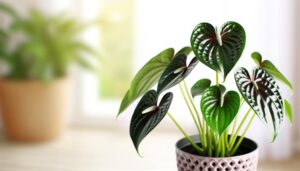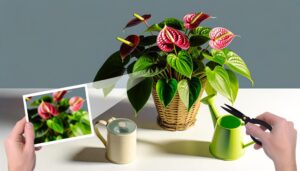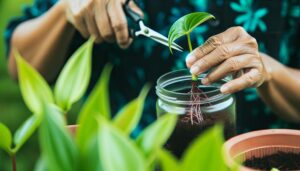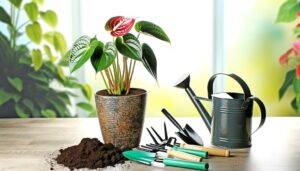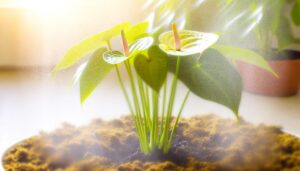How to Care for Anthurium Hybrids – A Complete How-To Guide
To care for Anthurium hybrids, place them in bright, indirect light and avoid direct sunlight. Water every 1-2 weeks using distilled or rainwater, allowing the top inch of soil to dry out.
Use a well-aerated, slightly acidic soil (pH 5.5-6.5). Maintain humidity levels at 70-80% and temperatures between 65-75°F with minimal fluctuations.
Fertilize with a balanced, water-soluble fertilizer every 6-8 weeks at half-strength. Prune regularly with sterilized shears and repot every 1-2 years.
Vigilantly monitor and treat for pests. Mastering these steps guarantees vibrant Anthuriums thrive; there’s more to explore for prime care.

Key Takeaways
- Provide bright, indirect light and avoid direct sunlight.
- Water every 1-2 weeks using distilled or rainwater, allowing soil to slightly dry between waterings.
- Maintain humidity levels between 70-80% and temperatures between 65-75°F.
- Fertilize every 6-8 weeks with a balanced, water-soluble fertilizer diluted to half-strength.
- Repot every 1-2 years and regularly check for pests and diseases, isolating and treating affected plants.
Ideal Lighting Conditions
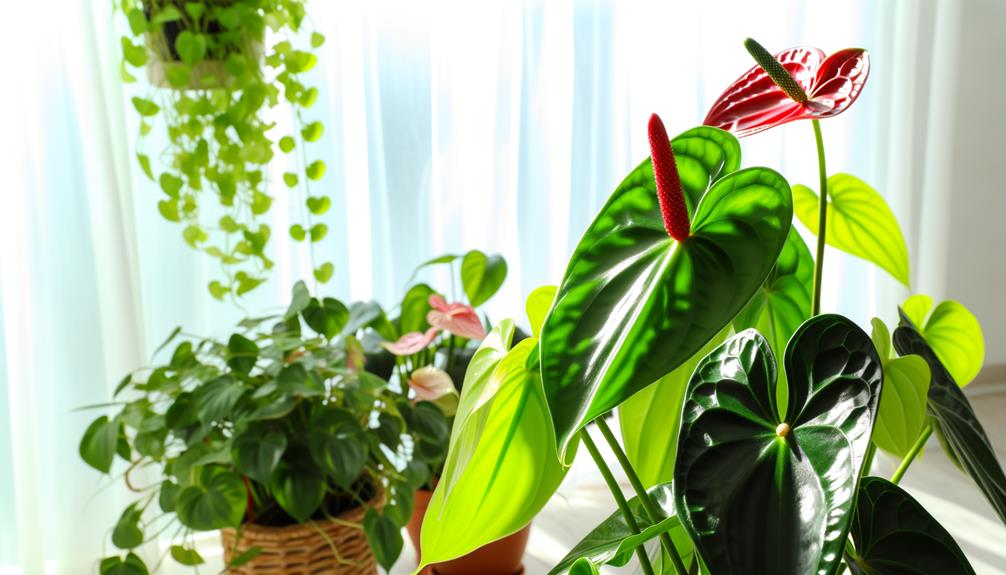
To promote optimal growth for your Anthurium hybrids, provide them with bright, indirect light, avoiding direct sunlight which can result in leaf burn.
Position your plants near east or north-facing windows, where they’ll receive abundant diffused light without exposure to harsh rays.
If natural light is inadequate, consider using fluorescent grow lights placed about 12 inches above the plants.
Maintain a photoperiod of 12-16 hours daily to mimic their native tropical environment. Monitor light intensity with a light meter, guaranteeing levels stay between 1,000 to 2,000 foot-candles.
Overexposure can cause chlorosis, while insufficient light may hinder flowering. By fine-tuning their light conditions, you’ll guarantee your Anthurium hybrids thrive and showcase their vibrant, exotic blooms, delighting those you serve.
Proper Watering Techniques
When watering your Anthurium hybrids, maintain an ideal watering frequency of once every one to two weeks, depending on environmental humidity.
Utilize distilled or rainwater to prevent harmful mineral buildup, ensuring best water quality.
Avoid waterlogged soil by allowing the substrate to dry slightly between waterings, which prevents root rot and promotes healthy growth.
Ideal Watering Frequency
Anthurium hybrids should be watered thoroughly once the top inch of soil feels dry to the touch, making sure the root zone remains moist but not waterlogged. To determine this, insert your finger into the soil up to the knuckle. If dry, it’s time to water.
Utilize a watering can with a narrow spout to direct water precisely at the base of the plant, minimizing foliar moisture which can cause fungal issues. Ensure water drains freely from the pot’s drainage holes, preventing standing water.
Maintain a consistent watering schedule, adjusting frequency based on seasonal changes and indoor humidity levels.
Regularly monitor soil moisture with a moisture meter for more precise readings, providing optimal hydration to your Anthurium hybrids.
Water Quality Importance
Securing high water quality is crucial for the health of Anthurium hybrids, as impurities like chlorine, fluoride, and heavy metals can hinder growth and harm delicate roots.
Use distilled or rainwater to minimize these risks. If tap water is your only choice, let it sit out for 24 hours to allow chlorine to disperse.
Test water pH; Anthuriums thrive in slightly acidic conditions (pH 5.5-6.5). Use a pH meter to guarantee accuracy.
Regularly check for dissolved solids; high levels can cause nutrient imbalances. Utilize a water filter if needed.
Consistently using clean, well-balanced water promotes vibrant foliage and robust flowering. By prioritizing water quality, you’re safeguarding your Anthurium hybrids flourish and remain resilient.
Avoiding Waterlogged Soil
Maintaining proper watering methods is crucial to prevent waterlogged soil, which can lead to root rot and negatively impact the health of your Anthurium hybrids.
Make sure that the soil is well-draining by utilizing a mix that includes perlite, peat, and orchid bark.
Water your Anthurium thoroughly but allow the top inch of soil to dry out between waterings. Avoid letting the plant sit in water by using pots with drainage holes.
| Method | Description | Frequency |
|---|---|---|
| Soil Blend | Perlite, peat, orchid bark | As required |
| Thorough Watering | Water until excess drains out | Weekly |
| Allow Top Inch to Dry | Let top layer dry before next watering | Check bi-weekly |
| Adequate Drainage | Containers with drainage to prevent water accumulation | Always |
Keep an eye on humidity levels as Anthuriums flourish in 60-80% humidity.
Choosing the Right Soil

When choosing soil for Anthurium hybrids, you should prioritize a well-aerated mix that balances moisture retention and drainage. Opt for a composition that includes orchid bark, perlite, and peat moss to promote proper root aeration and prevent waterlogging.
Additionally, maintain the soil pH between 5.5 and 6.5 to support ideal nutrient uptake.
Ideal Soil Composition
Selecting the best soil composition for anthurium hybrids involves combining well-draining components like orchid bark, perlite, and peat moss to mimic their natural epiphytic environment. Begin by mixing equal parts of orchid bark and perlite.
Orchid bark provides aeration, while perlite enhances drainage. Adding peat moss helps retain necessary moisture without waterlogging the roots. This mixture replicates the loose, airy medium anthuriums thrive in.
Ensure the pH level remains slightly acidic, ideally between 5.5 and 6.5. You can test and adjust the pH using a soil test kit and appropriate amendments. Regularly monitor the soil to prevent compaction, which can inhibit root growth.
By maintaining this ideal soil composition, you support your anthurium hybrid’s health and crucial vigor.
Drainage Requirements
Securing ideal drainage for anthurium hybrids necessitates a carefully designed soil mix that prevents water retention and encourages root aeration.
Begin with a base of orchid bark, which offers excellent structure and drainage.
Integrate perlite to enhance aeration and prevent soil compaction.
Include peat moss to retain crucial moisture while still supporting drainage.
Strive for a composition of 1 part orchid bark, 1 part perlite, and 1 part peat moss. This well-rounded mixture facilitates optimal water flow and prevents root rot.
Regularly assess the soil’s texture to ensure it remains loose and well-draining.
Refrain from using dense garden soils, as they can retain excessive moisture, resulting in unfavorable conditions for your anthurium’s roots.
Soil Ph Levels
Achieve peak growth for your anthurium hybrids by maintaining a soil pH between 5.5 and 6.5, which maximizes nutrient availability and root health. Use a pH meter to periodically test the soil.
If the pH strays from this range, take corrective actions. Acidify alkaline soil with sulfur or peat moss and neutralize acidic soil with lime.
Follow these steps:
- Test Regularly: Maintain consistent monitoring with a quality pH meter.
- Adjust Accordingly: Use sulfur to lower pH and lime to raise it.
- Mix Precisely: Blend soil components (perlite, orchid bark) to maintain ideal acidity.
- Monitor Symptoms: Watch for yellowing leaves or stunted growth, signs of pH imbalance.
Maintaining precise soil pH helps your anthuriums thrive.
Humidity and Temperature
Maintaining perfect moisture levels between 70-80% and a temperature range of 65-75°F is crucial for the healthy growth of Anthurium hybrids. You can achieve this by using a humidifier or placing a water tray near your plants.
Regular monitoring with a hygrometer guarantees ideal conditions. Temperature fluctuations should be minimal to prevent stress on the plant.
Here’s a quick reference table for ideal conditions:
| Factor | Ideal Range | Notes |
|---|---|---|
| Humidity | 70-80% | Use a humidifier or water tray |
| Temperature | 65-75°F | Avoid sudden changes |
| Light | Indirect, bright | Prevent direct sunlight |
| Airflow | Moderate | Ensure good ventilation |
| Monitoring | Regular | Use hygrometers and thermometers |
Fertilizing Your Anthurium
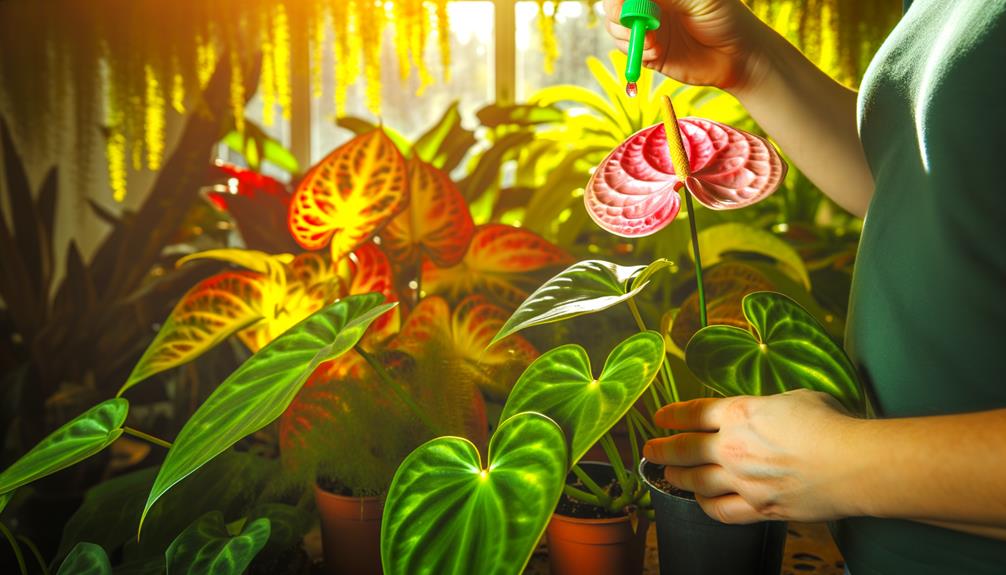
Applying a balanced, water-soluble fertilizer every 6-8 weeks will provide your Anthurium hybrids with essential nutrients for robust growth. Choose a fertilizer with an N-P-K ratio of 10-10-10 or 20-20-20 to maintain a balanced nutrient supply.
Dilute the fertilizer to half-strength to prevent root burn, and apply it during the plant’s active growing season, typically in spring and summer.
To optimize your fertilizing routine, follow these guidelines:
- Monitor leaf color: Yellowing may indicate a nutrient deficiency.
- Check soil pH: Aim for a slightly acidic to neutral pH (5.5-6.5).
- Water thoroughly before feeding: This helps distribute nutrients evenly.
- Avoid excessive fertilization: Excess nutrients can cause salt buildup, harming your plant.
Pruning and Repotting
In addition to proper fertilization, regular pruning and timely repotting are necessary to maintain the health and aesthetic appeal of your Anthurium hybrids. Start by pruning dead or yellowing leaves using sterilized pruning shears to prevent disease.
Cut close to the base without damaging healthy tissue. Repotting should occur every 1-2 years to provide fresh medium and adequate root space.
Choose a well-draining mix rich in organic matter. Gently remove the plant from its old pot, shake off excess soil, and place it in a slightly larger container.
| Task | Guidelines |
|---|---|
| Pruning | Use sterilized shears, cut near the base |
| Repotting Frequency | Every 1-2 years |
| Soil Mix | Well-draining, rich in organic matter |
| Pot Size | Slightly larger than current container |
Pest and Disease Management
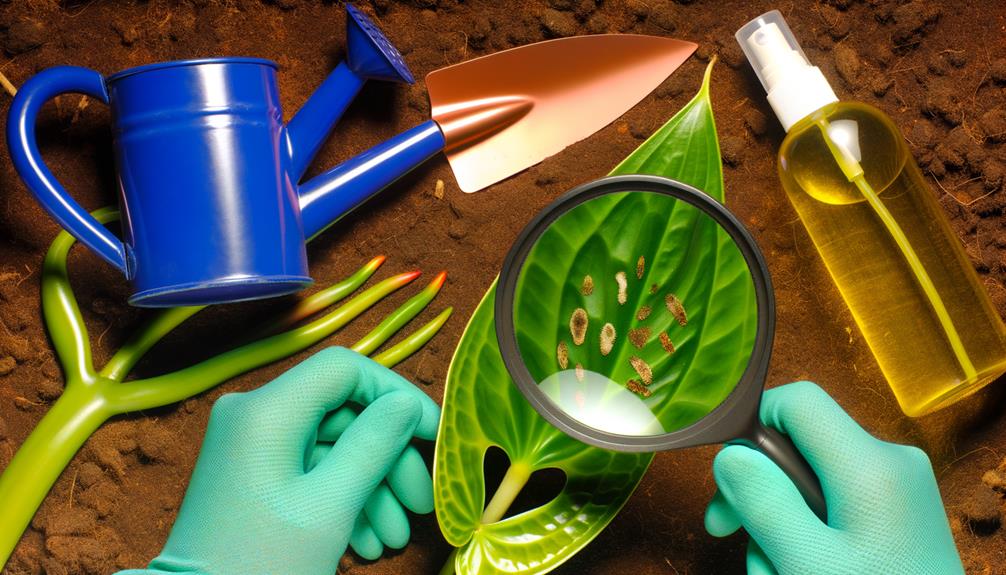
To effectively manage pests and diseases in Anthurium hybrids, regularly inspect the leaves and stems for signs of common issues such as aphids, mealybugs, and fungal infections.
Early detection is essential to prevent infestations from spreading. Use a magnifying glass to identify tiny pests and fungal spores. If you find any, act promptly:
- Isolate the affected plant to prevent contagion.
- Apply insecticidal soap or neem oil for pest control, following the manufacturer’s instructions.
- Use a fungicide to treat fungal infections, ensuring thorough coverage of affected areas.
- Maintain ideal humidity and airflow to inhibit fungal growth and discourage pests.
Common Care Mistakes
Why do so many Anthurium enthusiasts struggle with common care mistakes that could be easily avoided with a bit more attention to detail?
Over-watering is a prevalent issue; always confirm the potting medium is well-draining and allow the top inch to dry out before re-watering.
Improper lighting is another pitfall; Anthuriums thrive in bright, indirect light but suffer under direct sunlight, which can scorch their leaves.
Neglecting humidity needs can also be detrimental; these tropical plants prefer humidity levels around 60-80%.
Additionally, avoid placing them in drafty areas or near heating vents, as temperature fluctuations can lead to stress.
Conclusion
To sum up, mastering anthurium hybrid care isn’t just about following steps—it’s about creating a thriving environment. By ensuring best lighting, precise watering, ideal soil composition, and maintaining proper humidity and temperature, you’re not just growing a plant; you’re cultivating a piece of nature’s art.
Remember, the smallest misstep can cascade into larger issues, so attention to detail is paramount. Your dedication will be rewarded with vibrant, healthy anthuriums that flourish under your expert care.


